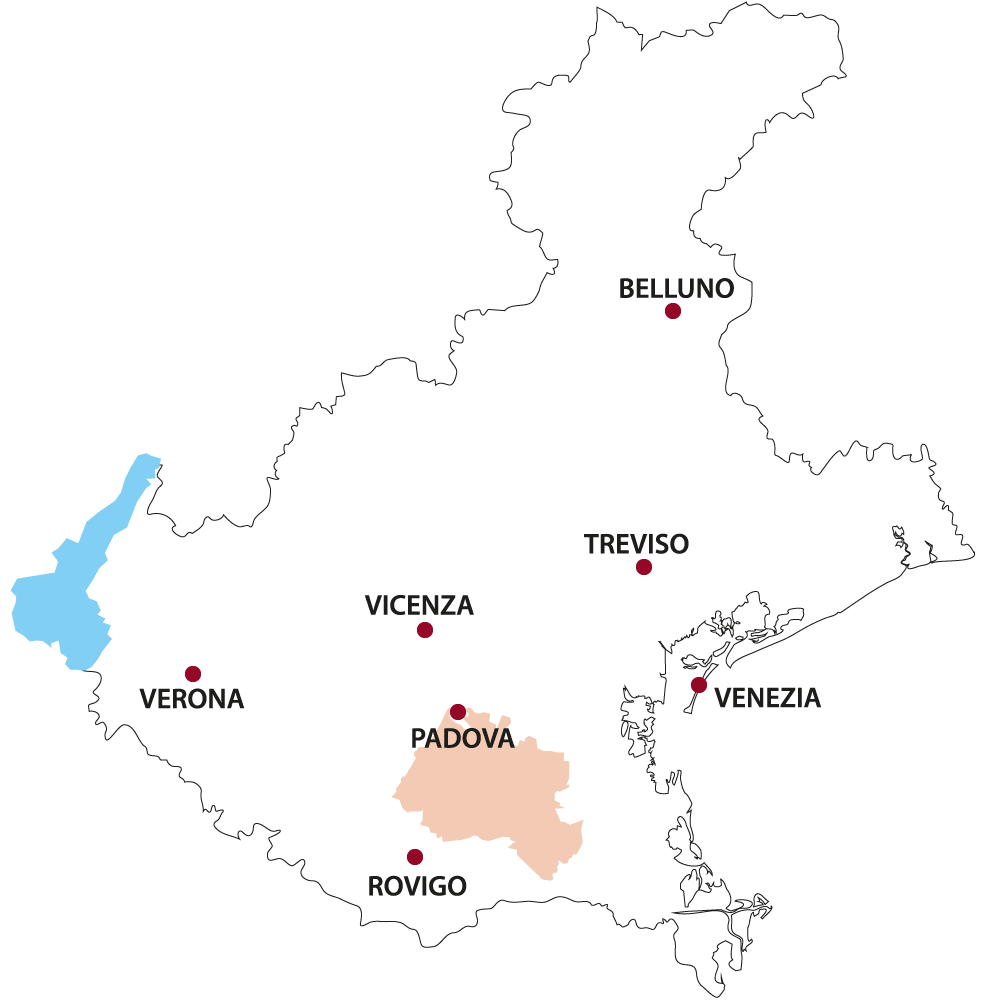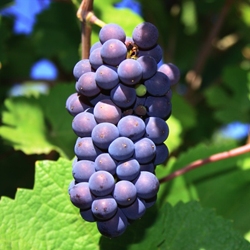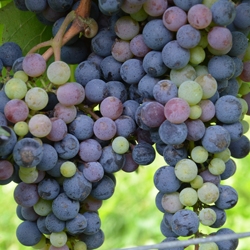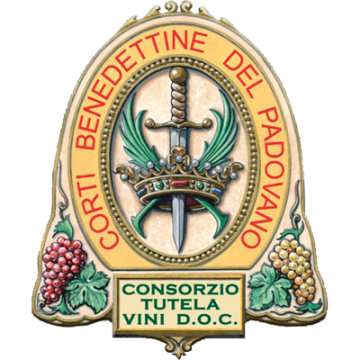

Zona di produzione
The territory of the “Corti Benedettine del Padovano”, D.O.C. established in 2004, extends across the south-east area of the province of Padua and the southern part of the province of Venice and is naturally bounded by the Adige, Bacchiglione and Brenta rivers. A territory that was once dominated by the water, where man has always worked hard in order to establish the necessary balances for cultivation. The untiring work of the monks of St. Benedict has guaranteed a productive future to these ancient lands and has created, starting from the ninth century, a model for the management of the territory that has proved to be over the centuries, functional to a cyclopean work of reclamation. The great abbeys of Saint Giustina of Padua, Saint Michele Brondolo, Saint Giorgio in Venice subdivided the territory in homogeneous units that were then assigned and governed by Corti (Courts), large agricultural administrative centres equipped with squares, arcades, cellars, joiners’ shops, stables, barns and residential areas. The Courts were the place of delivery of all agricultural products that were here processed and transformed before being transported to the city. The work of the monks continued for nine centuries with an invaluable contribution to the cultivability as well as to the cultivation of these lands. Chamberlains and peasants cultivated the lands following the agronomic indications of the monks, agriculture became the most productive activity of the area and viticulture, together with wheat, became the main products for value and volume of production. After the Napoleonic and Savoy harassments, the territory of the Corti Benedettine is rediscovering its ancient vocation for wine production and the productive capacity of wines of excellence. Nowadays, the territory retains significant areas of vineyards that can yield a wide variety of wine, both white and red. The establishment of the D.O.C. has allowed to reinforce the wine-making tradition of the area focusing on quality and on the link with the territory.
Caratteristiche e tipologie vino
The territory of the Corti Benedettine del Padovano D.O.C. has all types of terrains: from clay to sandy, to soils of medium texture. This makes it possible to obtain both white and red wines of excellent quality, for there is a way of cultivating the variety that is best suited to a particular type of terrain for each oenological aim. There is a production of wines that can be consumed young and may be appreciated for their freshness accompanied by strong floral notes; others instead are more suitable for a more or less long-term aging so that the bouquet and taste gain a major aromatic complexity and an elegant structure together with a high level of softness. When producing the Passito type (yellow Muscat grapes) the grapes cannot be pressed before 31st December of the year of harvest and must reach a sugar content of at least 270g/l. The Spumante type must be obtained exclusively by natural fermentation in bottles or autoclave, using the musts or the wines made from the vines of the Chardonnay and yellow Muscat while the Sparkling version must be obtained exclusively by natural fermentation in bottles or autoclave, using the musts or the wines made from the Chardonnay vineyard variety. The yield of grapes into wine must not exceed 70%, with the exception of the Passito type. As for the Spumante and Sparkling versions, these yields are considered net of the allowed additions of the batch (cuvee). The maximum yield of fresh grapes into wine ready for consumption must not exceed 45% for the Passito and Raboso Passito versions. The Cabernet, Raboso and Refosco dal peduncolo rosso wines, may be designated by the expression Riserva, only after they have been subjected to a period of aging of at least two years, of which at least 6 months in wooden casks, with effect from 1st November of the year of harvest.
Grapes
-

PINOT GRIGIO
-

RABOSO
The secular experience of the Corti Benedettine lives on to this day in the vineyards and wine cellars of this part of the Veneto region where beside the historical and autochthonous vines such as Raboso, Refosco, the Tai (former Tocai) and Muscat, are also cultivated the so called international vines: Merlot, Cabernet, Chardonnay, Sauvignon, Pinot Gris and Pinot Blanc, that have found here excellent conditions of climate and terrain. The most suitable form of viticulture is the spurred cordon, which is rapidly replacing the Sylvoz method, because it offers better quality results but also because of the greater ease of some cultivation operations such as winter pruning, summer pruning, topping and distribution of crop-protection. The most widespread autochthonous vine is the Raboso, as it is rustic and able to adapt to all types of soil, although the ideal is the alluvial plain. It is probably due to this resistance that the Raboso was able to pass almost unscathed through the scourge of phylloxera. Though a little concealed in the recent past, the Raboso has come out on top over the last years thanks to the work of producers who have enhanced its properties. The rediscovery of wines obtained from the withering of these grapes is particularly appreciated because they have a well-balanced acidity that is typical of this variety as well as a sweetness conferred by the technique of drying
White Wines
CORTI BENEDETTINE BIANCO
Colour: straw-like yellow
Bouquet: fruttato con sentore di vaniglia, intenso e caratteristico;
Taste: asciutto, sapido, fine;
Alcoholic Strength minimum total volume: 10,50%
Accompaniments: minestre, pesce, formaggi teneri.
CORTI BENEDETTINE TAI
Colour: straw-like yellow
Bouquet: pleasant, characteristic
Taste: asciutto, fresco, armonico;
Alcoholic Strength minimum total volume: 11,00%
Accompaniments: antipasti di verdure, risotti, pesce.
CORTI BENEDETTINE PINOT BIANCO
Colour: light straw-like;
Bouquet: delicate, characteristic
Taste: dry, well-balanced, fresh, full-bodied
Alcoholic Strength minimum total volume: 11,50%
Accompaniments: fish, vegetable soups.
CORTI BENEDETTINE PINOT GRIGIO
Colour: giallo paglierino con riflessi ramati;
Bouquet: intenso, delicato, leggermente aromatico;
Taste: Intenso, pieno, armonico;
Alcoholic Strength minimum total volume: 11,00%
Accompaniments: antipasti, risotti, minestre, pesce.
CORTI BENEDETTINE CHARDONNAY
Colour: straw-like yellow;
Bouquet: intenso, tipico, leggermente aromatico;
Taste: asciutto, vellutato;
Alcoholic Strength minimum total volume: 11,50%
Accompaniments: risotti, pesce.
CORTI BENEDETTINE SAUVIGNON
Colour: straw-like yellow;
Bouquet: caratteristico;
Taste: fresco, asciutto, armonico;
Alcoholic Strength minimum total volume: 11,50%
Accompaniments: aperitifs, soups, fish.
CORTI BENEDETTINE MOSCATO SPUMANTE
Colour: more or less intense straw-like yellow
Bouquet: aromatico intenso, caratteristico, fragrante;
Taste: dolce, aromatico, caratteristico;
Alcoholic Strength minimum total volume: 11% vol. (svolto 6% vol.);
Accompaniments: dolci secchi, crostate.
CORTI BENEDETTINE PASSITO
Colour: da giallo paglierino intenso a giallo dorato;
Bouquet: sweetish or sweet, well-balanced
Taste: sweetish or sweet, well-balanced
Alcoholic Strength minimum total volume: 13% vol. (svolto 11% vol.);
Accompaniments: vino da meditazione, biscotteria secca, frutta in guscio.
Red Wines
CORTI BENEDETTINE ROSSO
Colour: ruby red if young, tending to garnet if aged
Bouquet: vinoso, intenso e delicato;
Taste: asciutto, vellutato, armonico;
Alcoholic Strength minimum total volume: 11,00%
Accompaniments: pasta al ragù, arrosti di carne, selvaggina.
CORTI BENEDETTINE NOVELLO
Colour: ruby red
Bouquet: fruttato, vinoso, tipico;
Taste: asciutto, talvolta abboccato, armonico, vellutato;
Alcoholic Strength minimum total volume: 11,00%
Accompaniments: carni rosse, frutta secca.
CORTI BENEDETTINE ROSATO
Colour: rosato tendente al rubino;
Bouquet: piacevolmente vinoso, gradevole;
Taste: asciutto, armonico;
Alcoholic Strength minimum total volume: 11,00%
Accompaniments: aperitivi, minestre, carni bianche.
CORTI BENEDETTINE MERLOT
Colour: ruby red if young, tending to garnet if aged
Bouquet: intenso, fruttato, caratteristico;
Taste: asciutto, morbido, armonico;
Alcoholic Strength minimum total volume: 11,50%
Accompaniments: pasta al ragù, arrosti, carni rosse.
CORTI BENEDETTINE CABERNET
Colour: rosso rubino, tendente al granato se invecchiato;
Bouquet: vinoso, caratteristico e persistente;
Taste: asciutto, pieno, di corpo, austero e vellutato;
Alcoholic Strength minimum total volume: 11,5% vol., 12,5% vol. nella versione Riserva;
Accompaniments: carni arroste, selvaggina, carni in umido.
CORTI BENEDETTINE CABERNET SAUVIGNON
Colour: rosso rubino, tendente al granato se invecchiato;
Bouquet: caratteristico e persistente;
Taste: asciutto, pieno, di corpo, austero e vellutato;
Alcoholic Strength minimum total volume: 11,5% vol., 12,5% vol. nella versione Riserva;
Accompaniments: carni arroste e alla brace, animali di bassa corte in umido.
CORTI BENEDETTINE RABOSO
Colour: rosso rubino intenso, tendente al granato se invecchiato;
Bouquet: marcato, tipico, con profumi di marasca e di violetta con il prolungato invecchiamento;
Taste: secco, austero, sapido, piacevolmente acidulo;
Alcoholic Strength minimum total volume: 11% vol., 12,5% vol. nella versione Riserva;
Accompaniments: pasta al ragù, arrosti, brasati, selvaggina, formaggi stagionati.
CORTI BENEDETTINE REFOSCO DAL PEDUNCOLO ROSSO
Colour: rosso rubino, tendente al granato se invecchiato;
Bouquet: vinoso e caratteristico;
Taste: asciutto, delicato, di corpo;
Alcoholic Strength minimum total volume: 11,5% vol., 12,5% vol. nella versione Riserva;
Accompaniments: carni rosse, arroste o alla brace.
CORTI BENEDETTINE RABOSO PASSITO
Colour: more or less intense ruby red, sometimes with violet reflections;
Bouquet: vinoso, caratteristico, tipico, con profumo di violetta con il prolungarsi dell’invecchiamento;
Taste: da secco ad amabile, vellutato;
Alcoholic Strength minimum total volume: 14% vol.;
Accompaniments: pasticceria secca, frutta in guscio. Vino da meditazione.

